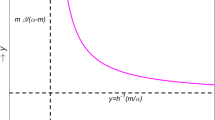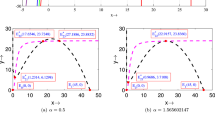Abstract
The environmental carrying capacity is usually assumed to be fixed quantity in the classical predator–prey population growth models. However, this assumption is not realistic as the environment generally varies with time. In a bid for greater realism, functional forms of carrying capacities have been widely applied to describe varying environments. Modelling carrying capacity as a state variable serves as another approach to capture the dynamical behavior between population and its environment. The proposed modified predator–prey model is based on the ratio-dependent models that have been utilized in the study of food chains. Using a simple non-linear system, the proposed model can be linked to an intra-guild predation model in which predator and prey share the same resource. Distinct from other models, we formulate the carrying capacity proportional to a biotic resource and both predator and prey species can directly alter the amount of resource available by interacting with it. Bifurcation and numerical analyses are presented to illustrate the system’s dynamical behavior. Taking the enrichment parameter of the resource as the bifurcation parameter, a Hopf bifurcation is found for some parameter ranges, which generate solutions that posses limit cycle behavior.







Similar content being viewed by others
References
Basener, B., & Ross, D. S. (2005). Booming and crashing populations and Easter Island. SIAM J. Appl. Math., 65, 684–701.
Collings, J. B. (1997). The effects of the functional response on the bifurcation behavior of a mite predator–prey interaction model. J. Math. Biol., 36, 149–168.
Diehl, S., & Feissel, M. (2000). Effects of enrichment on three-level food chains with omnivory. Am. Nat., 155(2), 200–218.
Diehl, S., & Feissel, M. (2001). Intraguild prey suffer from enrichment of their resources: a microcosm experiment with ciliates. Ecology, 82(11), 2977–2983.
Ermentrout, B. (2010). xppaut v, 6.00 2011.
Gakkhar, S., & Naji, R. K. (2003). Order and chaos in predator to prey ratio-dependent food chain. Chaos Solitons Fractals, 18, 229–239.
Gasull, A., Kooij, R. E., & Torregrosa, J. (1997). Limit cycles in the Holling-Tanner model. Publ. Mat., 41, 149–167.
Hin, V., Schellekens, T., Persson, L., & Roos, A. M. (2011). Coexistence of predator and prey in intraguild predation systems with ontogenetic niche shifts. Am. Nat., 178(6), 701–714.
Holt, R. D., & Polis, G. A. (1997). A theoretical framework for intraguild predation. Am. Nat., 149(4), 745–764.
Hoyle, A., & Bowers, R. G. (2007). When is evolutionary branching in predator–prey systems possible with an explicit carrying capacity? Math. Biosci., 210(1), 1–16.
Hsu, S. B., & Huang, T. W. (1995). Global stability for a class of predator–prey systems. SIAM J. Appl. Math., 55(3), 763–783.
Jordan, D. W., & Smith, P. (1987). Geometrical aspects of plane autonomous systems. Oxford applied mathematics and computing science series: In Nonlinear ordinary differential equations (p. 109). New York: Oxford University Press.
Korobeinikov, A. (2001). A Lyapunov function for Leslie-Gower predator–prey models. Appl. Math. Lett., 14, 697–699.
Korobeinikov, A., & Lee, W. T. (2009). Global asymptotic properties for a Leslie-Gower food chain model. Math. Biosci. Eng., 6, 585–590.
Lacitignola, D., & Tebaldi, C. (2003). Symmetry breaking effects on equilibria and time dependent regimes in adaptive Lotka-Volterra systems. Int. J. Bifurc. Chaos, 13(2), 375–392.
Leslie, P. H. (1958). A stochastic model for studying the properties of certain biological systems by numerical methods. Biometrika, 45(1/2), 16–31.
Leslie, P. H., & Gower, J. C. (1960). The properties of a stochastic model for the predator–prey type of interaction between two species. Biometrika, 47(3/4), 219–234.
MathWorks (2008). matlab v R2009a. The MathWorks, USA.
Mylius, S. D., Klumpers, K., de Roos, A. M., & Persson, L., (2001). Impact of intraguild predation and stage structure on simple communities along a productivity gradient. Am. Nat., 158(3), 259–276.
Polis, G. A., & Holt, R. D. (1992). Intraguild predation—the dynamics of complex trophic interactions. Trends Ecol. Evol., 7(5), 151–154.
Polis, G. A., Myers, C. A., & Holt, R. D. (1989). The ecology and evolution of intraguild predation: potential competitors that eat each other. Annu. Rev. Ecol. Evol. Syst., 20(1), 297–330.
Rosenzweig, M. L. (1971). Paradox of enrichment: destabilization of exploitation ecosystems in ecological time. Science, 171, 385–387.
Saez, E., & Olivares, E. G. (1999). Dynamics of a predator–prey model. SIAM J. Appl. Math., 59(5), 1867–1878.
Safuan, H. M., Towers, I. N., Jovanoski, Z., & Sidhu, H. S. (2012). Coupled logistic carrying capacity model. ANZIAM J., 53, C172–C184.
Seidl, I., & Tisdell, C. A. (1999). Carrying capacity reconsidered: from Malthus’s population theory to cultural carrying capacity. Ecol. Econ., 31, 395–408.
Seo, G., & Kot, M. (2008). A comparison of two predator–prey models with Holling’s type I functional response. Math. Biosci., 212, 161–179.
Sprott, J. C. (2011). Chaos in Easter Island ecology. Nonlinear Dyn. Psychol. Life Sci., 15(4), 445–454.
Tanner, J. T. (1975). The stability and the intrinsic growth rates of prey and predator populations. Ecology, 56, 855–867.
Walter, G. K., & Peterson, A. C. (2010). Autonomous system. In The theory of differential equations: classical and qualitative (pp. 134–135). New York: Springer.
Wang, F., & Pang, G. (2008). Chaos and Hopf bifurcation of a hybrid ratio-dependent three species food chain. Chaos Solitons Fractals, 36, 1366–1376.
Wang, Q., Fan, M., & Wang, K. (2003). Dynamics of a class of nonautonomous semi-ratio-dependent predator–prey systems with functional responses. J. Math. Anal. Appl., 278, 443–471.
Acknowledgements
HMS is thankful to M.I. Nelson for his help in the bifurcation analysis section. HMS acknowledges Universiti Tun Hussein Onn Malaysia and the School of Physical, Environmental, and Mathematical Sciences, UNSW Canberra for financial support.
Author information
Authors and Affiliations
Corresponding author
Rights and permissions
About this article
Cite this article
Safuan, H.M., Sidhu, H.S., Jovanoski, Z. et al. Impacts of Biotic Resource Enrichment on a Predator–Prey Population. Bull Math Biol 75, 1798–1812 (2013). https://doi.org/10.1007/s11538-013-9869-7
Received:
Accepted:
Published:
Issue Date:
DOI: https://doi.org/10.1007/s11538-013-9869-7




